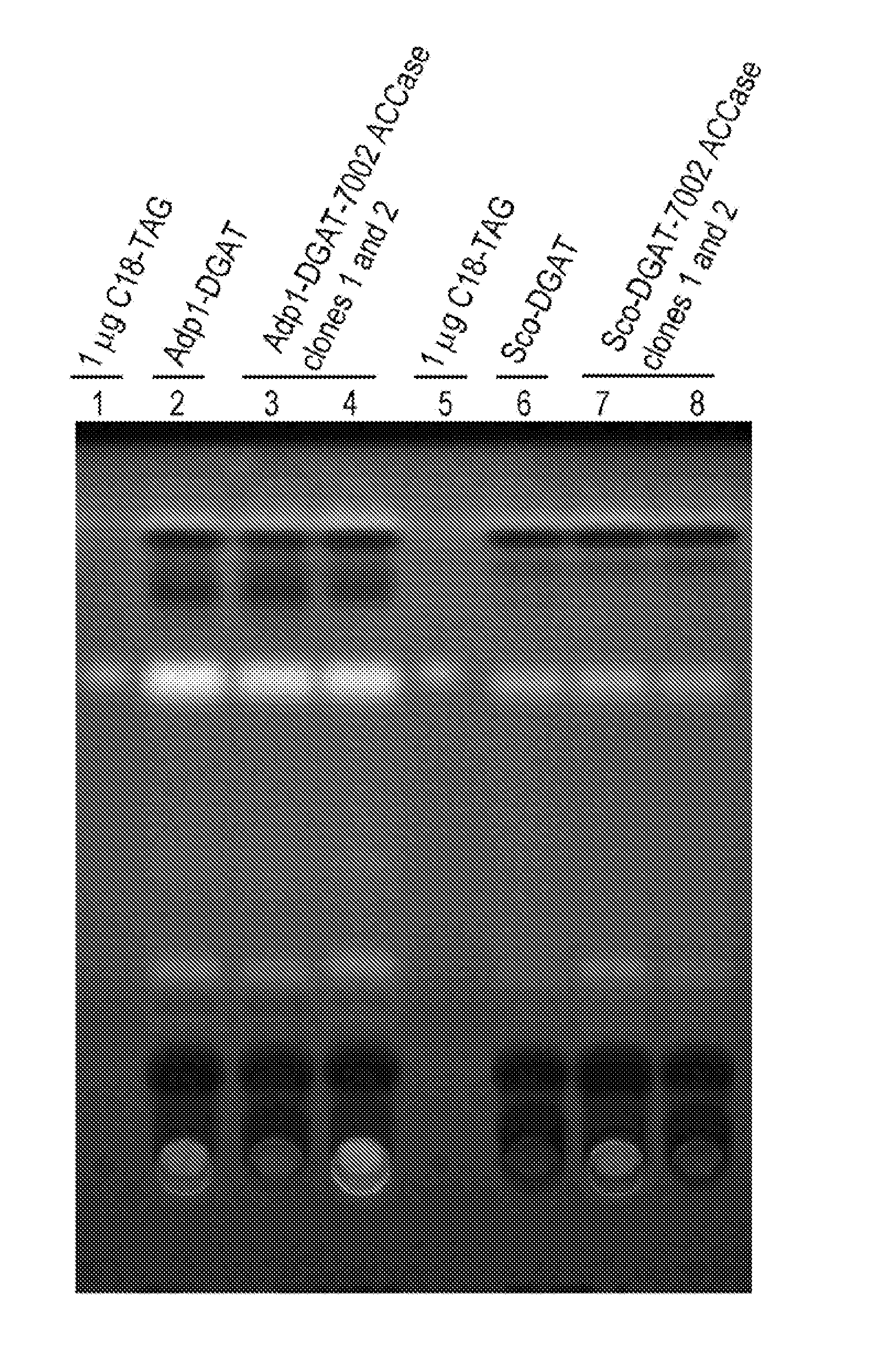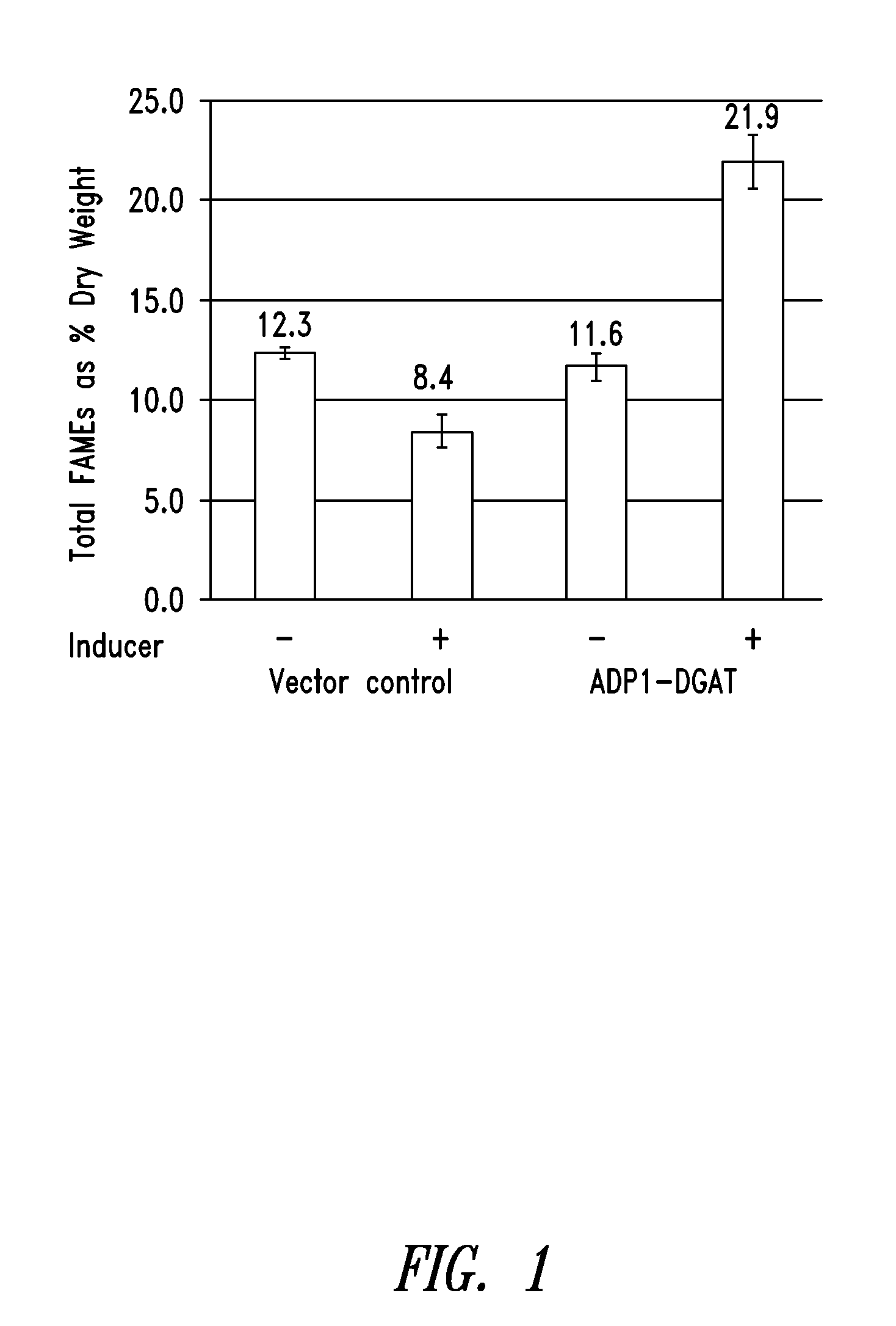Modified photosynthetic microorganisms for producing triglycerides
- Summary
- Abstract
- Description
- Claims
- Application Information
AI Technical Summary
Benefits of technology
Problems solved by technology
Method used
Image
Examples
example 1
Generation of DGAT and PAP-Expressing Cyanobacteria
[0224]Acinetobacter baylii sp. ADP1, a gram-negative TAG forming prokaryote, contains a well-characterized DGAT (AtfA, also referred to herein as ADP1-DGAT). The ADP1-DGAT nucleotide sequence was synthesized and codon optimized for Selongatus PCC 7942 expression using DNA2.0, received in a plasmid, subcloned using established molecular biology techniques into the IPTG-inducible vector pAM2991trc (this vector contains sequences encoding the lacI transcriptional repressor, and the pTrc promoter which is repressed by LacI), and recombined into neutral site 1 (NS1) of S. elongatus PCC 7942. Colonies were selected from BG11-spec / strep plates, restreaked for isolation, and tested by PCR for positive colonies. Inducible transcription of the gene was verified by real-time PCR
[0225]Saccharomyces cerevisiae contains three characterized phosphatidate phosphatases, one of which is a soluble, non-integral membrane protein, Pah1p (YMR165C). Pah1 ...
example 2
Generation of DGAT and ACCase-Expressing Cyanobacteria
[0227]Synechococcus sp. PCC 7002 contains fours genes encoding the four subunits of bacterial acetyl coenzyme A carboxylase (7002 acc). These genes (accA, accB, accC, and accD) were PCR amplified and two synthetic two-gene operons were constructed using splicing by overlap extension PCR techniques. Synthetic operon 1 contains accAD and synthetic operon 2 contains accBC. The two synthetic operons were cloned into vector pTG2087 (pAM2314Ftrc3.) The vector pTG2087 contains regions of homology for recombination into neutral site 1 (NS1) of S. elongatus PCC7942, sequences encoding the lacI transcriptional repressor, and the pTrc promoter which is repressed by LacI. Synthetic 7002 acc operons 1 and 2 were cloned into pTG2087, in two separate sites, under control of the pTrc promoter to generate plasmid pTG2087-7002acc. Clone candidates were sequenced to confirm that there were no PCR-induced mutations in the coding sequence of any of t...
example 3
Increased Fatty Acid Production in Cyanobacteria
[0232]ADP1-DGAT-expressing Cyanobacteria from Example 1 was tested for the ability to produce increased levels of fatty acids. Induction of ADP1-DGAT positive clones was carried out by the addition of 1 mM IPTG when culture reached an OD750=0.2. Samples were taken at 24 hours after induction, and analyzed for lipid content by gas chromatography (GC).
[0233]As seen in FIG. 1, GC results showed a 2-fold increase in lipid content for IPTG-induced DGAT compared to un-induced vector control.
PUM
 Login to View More
Login to View More Abstract
Description
Claims
Application Information
 Login to View More
Login to View More - R&D
- Intellectual Property
- Life Sciences
- Materials
- Tech Scout
- Unparalleled Data Quality
- Higher Quality Content
- 60% Fewer Hallucinations
Browse by: Latest US Patents, China's latest patents, Technical Efficacy Thesaurus, Application Domain, Technology Topic, Popular Technical Reports.
© 2025 PatSnap. All rights reserved.Legal|Privacy policy|Modern Slavery Act Transparency Statement|Sitemap|About US| Contact US: help@patsnap.com



